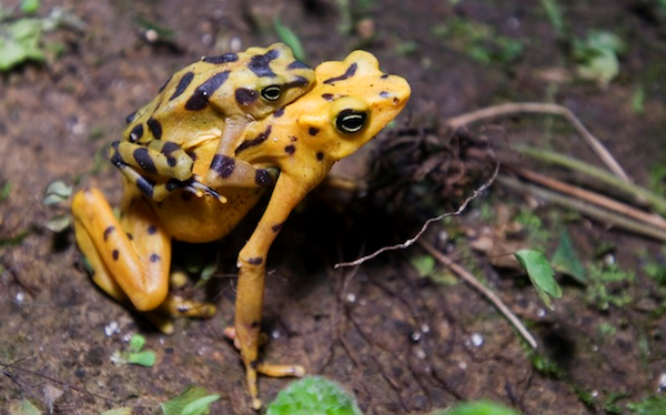Reproduction
 The
life of a Panamanian Golden Frog takes place in both aquatic and
terrestrial environments. Despite these organisms living
on land in their adult stage, they still require the water in
their infancy; a characteristic of all amphibious creatures.
The aquatic portion of their life is experienced as a tadpole,
and the terrestrial portion of their life is experienced as a
frog. The transition between these two life stages is
called metamorphosis and is a very important time in the frog's
life. Another very cool amphibious creature to check out
is
Ambystoma tigrinum, otherwise known as the Tiger
Salamander.
The
life of a Panamanian Golden Frog takes place in both aquatic and
terrestrial environments. Despite these organisms living
on land in their adult stage, they still require the water in
their infancy; a characteristic of all amphibious creatures.
The aquatic portion of their life is experienced as a tadpole,
and the terrestrial portion of their life is experienced as a
frog. The transition between these two life stages is
called metamorphosis and is a very important time in the frog's
life. Another very cool amphibious creature to check out
is
Ambystoma tigrinum, otherwise known as the Tiger
Salamander.
 The
mating season for the Panamanian Golden Frog takes place in the
transition between the wet and dry seasons. This usually
equates to late November or early December proceeding into January.
The first step in the reproductive process is for a male to find a
female mate; a process known to be very competitive among the male
population. When a suitable female is found, the male frog
approaches the female and climbs on her back; this process is called
amplexus. The female then finds the site in which she wishes
to lay her eggs, otherwise known as ovipositioning. Desirable
sites are usually within the margins (less than 2 meters) of nearby
streams on boulders or other rocky substrates for easy access to the
water. When the site is found, the female releases her eggs
and the male releases his sperm simultaneously to form a chain of
fertilized eggs. There will typically be between 200 and 600
eggs laid in the chain that are creamy white in color. It is
common for the tadpoles to hatch from the eggs within 7 to 10 days.
The
mating season for the Panamanian Golden Frog takes place in the
transition between the wet and dry seasons. This usually
equates to late November or early December proceeding into January.
The first step in the reproductive process is for a male to find a
female mate; a process known to be very competitive among the male
population. When a suitable female is found, the male frog
approaches the female and climbs on her back; this process is called
amplexus. The female then finds the site in which she wishes
to lay her eggs, otherwise known as ovipositioning. Desirable
sites are usually within the margins (less than 2 meters) of nearby
streams on boulders or other rocky substrates for easy access to the
water. When the site is found, the female releases her eggs
and the male releases his sperm simultaneously to form a chain of
fertilized eggs. There will typically be between 200 and 600
eggs laid in the chain that are creamy white in color. It is
common for the tadpoles to hatch from the eggs within 7 to 10 days.

Courtesy of the Canopy Tower Family.
Photo taken by David Tipling.
Tadpole Facts: The newly hatched tadpoles lack pigmentation and are the same color white as the eggs they were hatched from, but pigmentation begins to develop after 2 to 3 days. The tadpole undergoes 44 stages in its life before it begins metamorphosis at stage 45. In the middle of their life at stage 36, the tadpoles have a body length of around 5.8 mm and a total length of around 12.2 mm (includes tail). Some distinguishing characteristics are their flattened ventral surface and large mouth in proportion to their body.
Note: Unless labeled, all images used under public permission.
To continue on to the Panamanian Golden Frog's interactions, click here.
Are you lost? Go back HOME.
